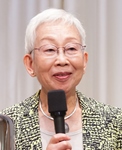Building a Girls�� Secondary School at the foot of Kilimanjaro
September 30, 2015
Ms. Sumiko Iwao
Chair, Group Kilimanjaro, Inc.
Professor Emeritus, Keio University and Tokyo City University
�� Mount Kilimanjaro is located in northern Tanzania, East Africa. Efficient flight connections allow smooth access to the Kilimanjaro International Airport from Japan. Sakura Girls Secondary School is currently under construction, located about 40 minutes from the Airport which serves as the gateway to the surrounding wildlife sanctuaries.
Mount Kilimanjaro is located in northern Tanzania, East Africa. Efficient flight connections allow smooth access to the Kilimanjaro International Airport from Japan. Sakura Girls Secondary School is currently under construction, located about 40 minutes from the Airport which serves as the gateway to the surrounding wildlife sanctuaries.
��I became involved in Tanzania through my close friend in the US, whose son had spent one year for an exchange program and stayed with a Masai lady at the foot of Kilimanjaro. I came to know her well and we launched a microcredit project to provide loans to poor women and assist their self-reliance. Thanks to our dedicated local staff members, the project has expanded into a plan to construct a secondary school.
��Tanzania has a land area 2.5 times larger than Japan where 49 million people reside. High population growth rate poses a challenge. Between 2010 and 2015, its population increased by 6.27 million while in Japan population decreased by 1.32 million during the same period. GDP in Tanzania was 640 dollars in 2012, so the majority of its people live on less than US 2 dollars a day. The country is endowed with rich resources like coffee, tea, gold and diamonds, but poor human resource development has failed to lift Tanzania out of poverty. Therefore, we believe education is an urgent priority.
��Primary education in Tanzania is compulsory and lasts 7 years. Enrollment rate for the 6-year-secondary education, however, fails to reach 30%. What is more, the results in 2011 showed that there remains a wide gender gap between male (62.5%) and female (54.4%) students who obtained the Certificate of Secondary Education. This is not because female students are less competent but because they are forced to shoulder the huge burden of domestic chores. There is an urgent need for female education. Sakura Girls School aims to provide a 4-year general course and add a 2-year advanced course in the future to complete secondary education. The School is being constructed in a Masai village where marriage is often the only option for early teenage girls. Early marriage results in girls having many children and exacerbates poverty. Looking back on our history, we know that there is a negative correlation between school enrollment ratio and the number of births. The United Nations and other organizations strive to assist poor countries suffering from high infant, child and maternal mortality rates. It is proved that female education plays a significant role in reducing these risks and other related issues.
��Sakura Girls School aims to provide comprehensive education, ranging from health, environmental conservation, nutrition to international understanding, and create an intergenerational impact of educated mothers on the lives of their children. We also believe that by maximizing the potential of each student, we can nurture future female leaders who will enhance economic growth and social development and generate a positive impact on the global community.
��Providing assistance to female education in developing countries will reduce the burden on our future generation and eventually benefit the developed countries as a whole. There are many active middle-aged and senior citizens in Japan with abundant experience and expertise who can contribute to the development of global human resources. We can also foster a pro-Japanese generation and enhance our presence. Female education in Japan has evolved over 140 years through mission schools established by dedicated overseas missionaries. I believe it is now our turn to make such a contribution.
��Sakura Girls School is scheduled to open next January for girls from underprivileged families with high motivation but few opportunities. Each grade will have 50 students who stay in the school dormitory. Classes will be taught in English, with emphasis on science and maths. As Tanzania is still a male-dominated country, training female students in technology, medicine and science will empower them to advance in key professional areas of the labor market.
��The Japanese excel in paying utmost attention to details, meticulous refinement and making improvements that have advanced manufacturing in our country. We believe such Japanese merit and behaviour are versatile added value that ought to be taught to students in Tanzania. The School will showcase Japanese technology, products and culture and serve as a basis to deepen understanding of Japan.
��Construction of the school building is mainly funded by ODA (official development assistance). We ask for generous contributions to complete the three science labs and the library, required by the Tanzanian government to officially register the School. We also ask for your generous support to enable students from poor families to study and stay at the dormitory, totaling 120,000 yen a year per student. Students wishing to join the School want to become scientists, medical doctors or teachers and we hope to make their dreams come true.
��Education is not all about building schools. We will strive to identify means for economic self-sustainability in the local community. By tapping into income sources related to education or community development, we will ensure a self-reliant school administration.